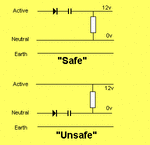Paradigm
Member level 1
Dear All Expert,
I am currently working on an electronic project. My electronic project was ran by DC power supply of 5V and 3.3V using a maximum of 100mA.
Currently, the AC to DC power supply was using transformer stepping down from 230V to 5VDC + rectifier + Capacitor + voltage regulator.
The problem I am facing now was the form factor of my power supply due to the big transformer. I had a space constraint for the PCB design. I got only 65mm by 65mm by 30mm of space to include all my power supply and the electronic circuit.
I had search the internet for "Transformerless Power Supply" and found some design that had no transformer. To my surprise, the circuit is far more simple then I thought.
My Question now was. Can this circuit be used in my electronic circuit to power up my ICs chip? Is there any safety concern? By connecting the rectifier onto the L and N, does this means my rectifier will be big in size also? Will I blown up my circuit should there by any parts failure? Will the L and N into the PCB create any unwanted noise to the PCB thereby interferring with my electronic circuit with had a RF transceiver in it.
I am surprise that Iphone charger and some model of the phone charger can be as small as a plug. Any expert can share how can it be done? Taking safety into consideration.
I need a 230VAC to DC power supply of 5V/3.3V maximum current of 200mA that can be safely integrated onto my electronic PCB with L/N in.
Thanks a lot for any advise.

I am currently working on an electronic project. My electronic project was ran by DC power supply of 5V and 3.3V using a maximum of 100mA.
Currently, the AC to DC power supply was using transformer stepping down from 230V to 5VDC + rectifier + Capacitor + voltage regulator.
The problem I am facing now was the form factor of my power supply due to the big transformer. I had a space constraint for the PCB design. I got only 65mm by 65mm by 30mm of space to include all my power supply and the electronic circuit.
I had search the internet for "Transformerless Power Supply" and found some design that had no transformer. To my surprise, the circuit is far more simple then I thought.
My Question now was. Can this circuit be used in my electronic circuit to power up my ICs chip? Is there any safety concern? By connecting the rectifier onto the L and N, does this means my rectifier will be big in size also? Will I blown up my circuit should there by any parts failure? Will the L and N into the PCB create any unwanted noise to the PCB thereby interferring with my electronic circuit with had a RF transceiver in it.
I am surprise that Iphone charger and some model of the phone charger can be as small as a plug. Any expert can share how can it be done? Taking safety into consideration.
I need a 230VAC to DC power supply of 5V/3.3V maximum current of 200mA that can be safely integrated onto my electronic PCB with L/N in.
Thanks a lot for any advise.



